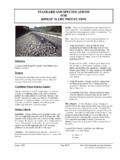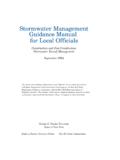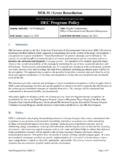Transcription of Species Status Assessment - dec.ny.gov
1 1 Species Status AssessmentClass: Osteichthyes (bony fishes) Family: Percidae (perch) Scientific Name: Percina macrocephala Common Name: Longhead darter Species synopsis: The longhead darters historical range included the Ohio River basin from southwestern New York, western Pennsylvania, and eastern Ohio southward through Kentucky, West Virginia, and Tennessee. Populations in North Carolina, western Virginia, and in the upper Tennessee River drainage in eastern Tennessee are now regarded as a distinct Species (P. williamsi) (NatureServe 2012). Many populations are believed to be extirpated, resulting in a relatively widespread but spotty distribution.
2 Longhead darters occur in medium-sized and larger streams with clean gravel and are native to the Allegheny watershed. Range and abundance have increased in New York over the last 20 years and populations seem to be secure. and Legal Protected Listed_____ Candidate: __No__ York_____Threatened, SGCN_____ Heritage Program York_____S1_____ Tracked by NYNHP __Yes__ Other Rank: Species of Northeast Regional Conservation Concern (Therres 1999) IUCN Red List Category: Near Threatened American Fisheries Society Status : Vulnerable (2008) 2 Status Discussion: Longhead darter is globally ranked as Vulnerable because this Species is rare and highly localized with a spotty distribution in the Ohio River basin.
3 It has become extirpated in several portions of its range due to a narrow habitat preference and is threatened by habitat destruction/degradation (pollution, siltation, impoundments) (NatureServe 2012). It is ranked Critically Imperiled and state listed as Threatened in New York due to its restricted distribution and abundance by habitat requirements. II. Abundance and Distribution Trends a. North America i. Abundance __X___ declining _____increasing _____stable _____unknown ii. Distribution: __X __ declining _____increasing _____stable _____unknown Time frame considered: __Based on long-term trends (NatureServe 2012) _ b. Regional i.
4 Abundance __X__ declining _____increasing _____stable _____unknown ii. Distribution: __X__ declining _____increasing _____stable _____unknown Regional Unit Considered:__Region 5- Northeast ( Species of Concern) Time Frame Considered: _____ _____ 3 c. Adjacent States and Provinces CONNECTICUT Not Present ____X____ No data _____ MASSACHUSETTS Not Present ____X____ No data _____ NEW JERSEY Not Present ____X____ No data _____ ONTARIO Not Present ____X____ No data _____ QUEBEC Not Present ____X____ No data _____ VERMONT Not Present ____X____ No data _____ PENNSYLVANIA Not Present _____ No data _____ i.
5 Abundance _____ declining _____increasing _____stable _____unknown ii. Distribution: _____ declining _____increasing _____stable _____unknown Time frame considered: _____ _____ _____ _____ Listing Status : __ _____Not Listed (S2S3); formerly Threatened_ SGCN? __Yes _ d. NEW YORK No data _____ i. Abundance _____ declining _____increasing ___X__ stable _____unknown ii. Distribution: _____ declining _____increasing ___X__ stable _____unknown Time frame considered: _____ _____ Monitoring in New York. There are monitoring programs carried out by the Rare Fish Unit, 1998-2012. 4 Trends Discussion: Collecting methods may have underestimated abundance and distribution in some northern populations.
6 Recent efforts directed specifically at longhead darters have been more successful, but perhaps abundance is cyclic (NatureServe 2012). Over the long term, extent of occurrence, area of occupancy, number of subpopulations, and population size clearly have declined, and this darter has been extirpated from much of its range (Page 1978, NatureServe 2012). In West Virginia, the Species is still relatively common in the Elk River system, but recent land use changes resulting from coal mining have begun to affect aquatic habitats there. In Kentucky, the Species is probably extirpated from the Cumberland and Kentucky rivers, each of which has one substantiated record, but current Status is relatively stable in Kentucky.
7 In Tennessee, the Species is rare to extirpated in various streams, and it has not been found in the Cumberland River since 1891 (Natureserve 2012). In New York, longhead darter has historically been found in five waters; it still occurs in these five. The population appears to be stable in the eastern and western sub-basins of the Allegheny but its Status is uncertain in French Creek. There has been an increase in catches (as % frequency occurrence) in comprehensive stream surveys of the watershed shifting from 3% in the 1930s and to 16% in 2000s. Statewide, the number of records for this Species in the last 30 years has been 86, compared to 27 reports prior to 1977.
8 The distribution of this Species among sub-basins within this watershed (HUC 10) has not changed substantially, with records from 7 of the units from all time periods and from 7 units since 1976. 5 Figure 1. distribution of longhead darter by watershed (NatureServe 2012). Figure 2. Longhead darter distribution in New York, depicting fish sampled before 1977 and from 1977 to current time, shown with the corresponding HUC-10 units where they were found, along with the number of records. Right map shows New York range of longhead darter.
9 6 Watershed name Total # HUC10 Early only Recent only both Allegheny 7 4 3 Table 1. Records of rare fish Species in hydrological units (HUC-10) are shown according to their watersheds in early and recent time periods (before and after 1977) to consider loss and gains. Further explanations of details are found in Carlson (2012). III. New York Rarity, if known: Historic # of Animals # of Locations % of State prior to 1977 _____ _27 reports 1/18 watersheds prior to 1980 _____ _____ _____ prior to 1990 _____ _____ _____ Details of historic occurrence: In New York State, the longhead darter has lived in the Allegheny River and French Creek, from the earliest surveys of 1937.
10 The area now covered by Allegheny Reservoir included some of the historic sites and it is no longer found there. French Creek records are for 1937, 1972 and 1973. Current # of Animals # of Locations % of State (since 1977) _____ __86 reports__ 1/18 watersheds Details of current occurrence: Longhead darter currently inhabit the Allegheny River, three nearby tributaries, and French Creek. Recorded catches were from the Allegheny River since 1960 at Portville, Carrollton and Weston Mills and at Allegany (village) (Becker 1982, Daniels 1989). Tributary samples came from the lower segments of Great Valley Creek, Olean Creek, and Oswayo Creek (Becker 1982, Gutowski letter dated 1992).













